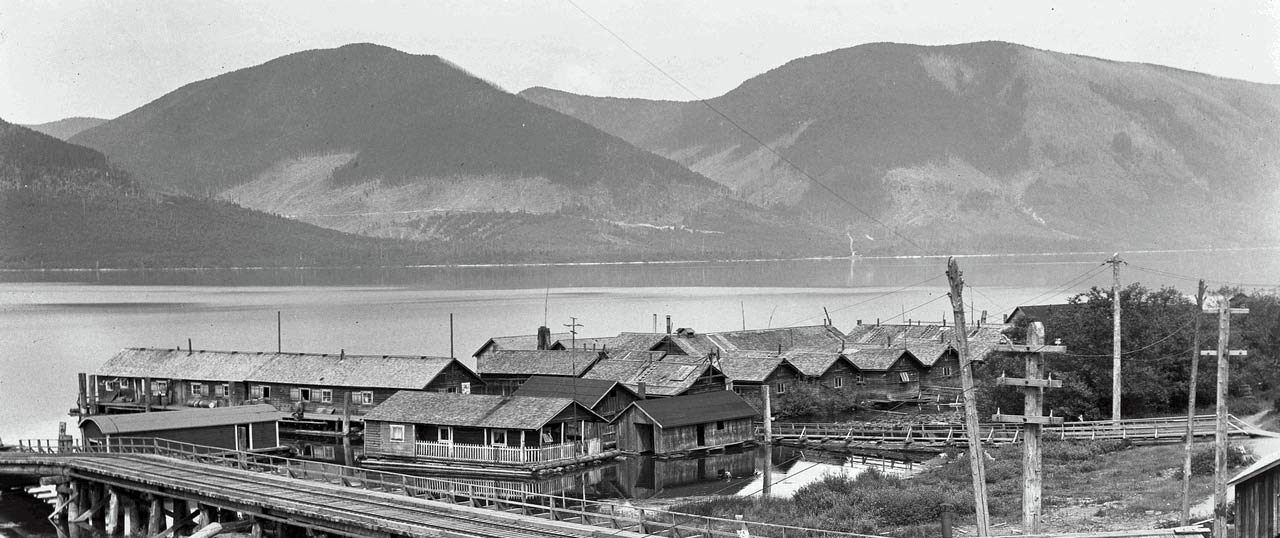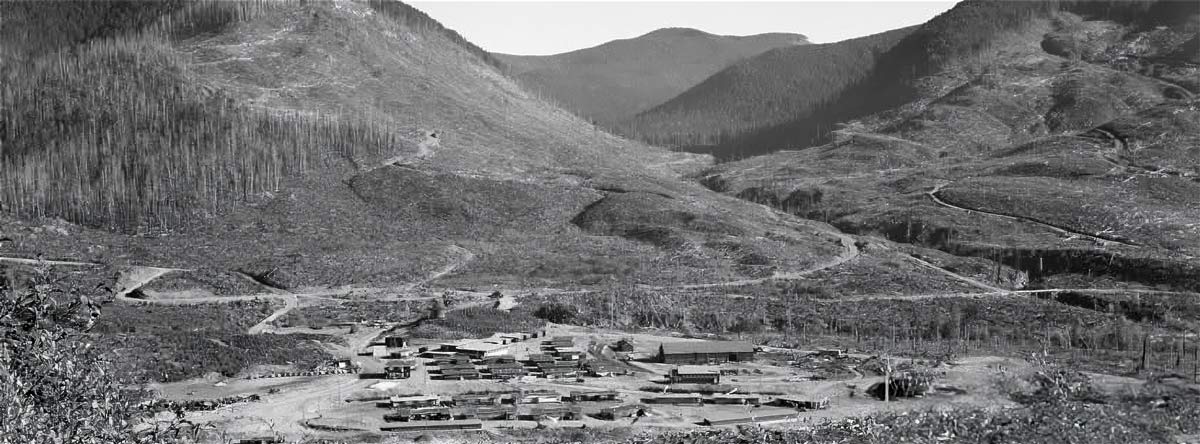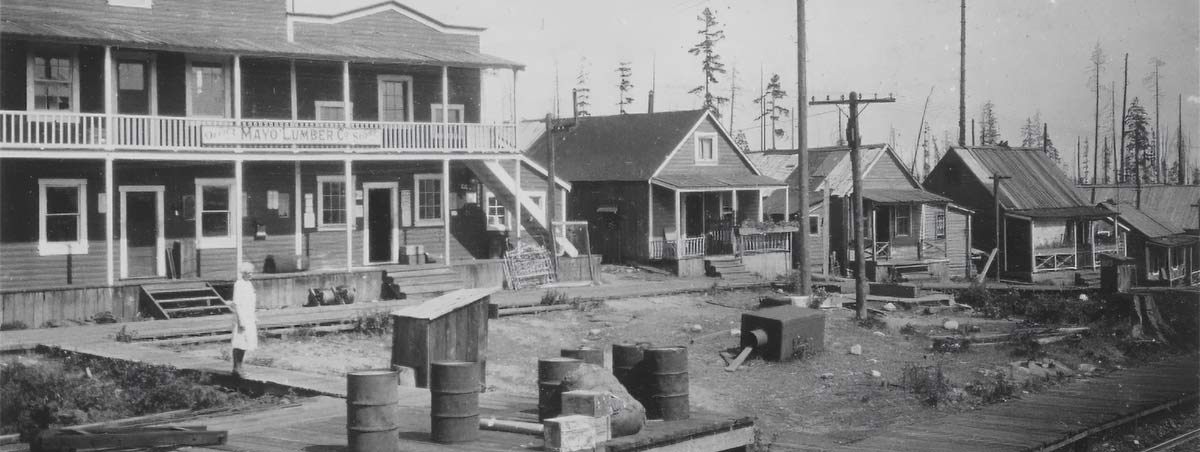From Axes to Ecosystems: The Evolution of Forestry Life in Canada
Disclaimer: This website is an independent educational project focused on Canada’s forestry heritage and sustainable communities. We are not affiliated with any government agency, museum, or prior digital exhibit. All content is original and based on publicly accessible historical information and general knowledge, shared under the principles of fair dealing for research, education, and commentary. We do not claim authority over Indigenous histories and encourage readers to learn directly from local Nations and their heritage organizations.

Canadian forestry communities began as temporary logging camps that housed workers near cutting sites. As industries modernized and families settled permanently, many camps evolved into full towns with schools, local services, and a growing focus on sustainability.
Forests across Canada have always been more than timber reserves – they have supported livelihoods, fuelled provincial economies, and shaped ideas about community and environmental stewardship. In the early 20th century, thousands of logging camps operated across the coastal rainforests of British Columbia, the boreal regions of Manitoba, and the hardwood valleys of Quebec and Ontario.
According to the article “Forestry” in Historica Canada’s The Canadian Encyclopaedia, about 38 % of Canada’s land area is forested and slightly more than half of that is commercial forest land.
Caycuse Camp – The Company Town That Lasted
Caycuse was one of Vancouver Island’s most established and longest-running logging communities. Founded near Nitinat Lake in the early 20th century, it became a fully serviced forestry town designed to attract families operated by Hillcrest Lumber Company and later TimberWest. Families lived in permanent houses with schools, recreation halls, and even a community store. The camp thrived throughout the 1960s and 1970s before evolving into a smaller, independent community in the 1980s.

Located on the traditional territory of the Lake Cowichan First Nation, Caycuse reflected how forestry towns supported generations of lumberjack jobs BC and sustained a growing Lake Cowichan population. It was also home to Sikh loggers in Canada, many of whom were connected to Paldi and inspired by pioneers like Mayo Singh, whose vision helped establish the Duncan Sikh Temple.
“One former logger from Caycuse once said the sound of the evening whistle was his favorite moment of the day – not because work ended, but because you could hear kids racing home on gravel roads and smell dinner cooking in every house.”
Today, Caycuse stands as a reminder of how industrial camps can evolve into self-sufficient towns built on strong local ties and a sense of pride in forestry.
Aspect | Details |
|---|---|
Location | Near Nitinat Lake, southwest Cowichan Valley |
Founded | Early 1900s |
Main Operator | BC Forest Products → Western Forest Products |
Notable Feature | Full company town with family housing and school |
Legacy | Transitioned into a lasting residential community |
Chapleau – Ontario’s Rail & Timber Backbone
Chapleau in northern Ontario grew at the crossroads of the Canadian Pacific Railway and massive forestry operations. Logging companies built bunkhouses, mills, and family neighbourhoods where workers lived year-round despite harsh winters. With Cree and other Indigenous communities nearby, the town evolved through both collaboration and cultural tension over land and resources.
Today, Chapleau remains a forestry hub while also promoting wildlife conservation through the Chapleau Crown Game Preserve – one of the largest protected areas in the world. The community strikes a balance between its industrial heritage and eco-tourism, embracing sustainable forest practices.
Aspect | Details |
|---|---|
Location | Northeastern Ontario |
Founded | Late 1800s (rail + logging expansion) |
Camp Type | Permanent rail-linked logging town |
Legacy | Active forestry operations + conservation leadership |
Gordon River Camp – Innovation in the Forest
Located near Port Renfrew, Gordon River Camp was one of the first sites to modernize large-scale logging in southwestern Vancouver Island. Its steep terrain demanded technical expertise and introduced mechanized yarding systems, replacing ox teams and even early steam donkey setups. These innovations reduced injuries while increasing production, helping shape what we now understand as a logging camp in the modern sense.

The camp supported both family homes and bunkhouses, providing steady employment through mid-island dryland sort operations. Even after the main logging ended, the area now connects forestry heritage trails with modern outdoor recreation, allowing modern visitors to explore old rail lines and forest routes that were once used by heavy equipment.
Aspect | Details |
|---|---|
Location | Near Port Renfrew, southwestern Vancouver Island |
Founded | 1910s |
Main Operator | BCFP and regional contractors |
Innovation | Early mechanized yarding and steep-slope logging |
Legacy | Forestry education and sustainable tourism hub |
La Tuque – Quebec’s Industrial Forest City
La Tuque in Mauricie originated as a cluster of riverside logging camps that supplied pulp and paper mills downstream. French-Canadian and immigrant workers transformed it into a structured city with schools, stout brick homes, and vibrant lumberjack culture.
Today, La Tuque advocates for sustainable forestry, biomass innovation, and forestry education – proving that industrial roots can lead to ecological leadership.
Aspect | Details |
|---|---|
Location | Québec (Mauricie region) |
Founded | Early 1900s |
Innovation | Hydropower + pulp and paper integration |
Legacy | Industrial resilience + renewable forestry focus |
Camp 6 – The Floating Logging Village
Camp 6 was one of the most unusual operations in British Columbia – a floating logging camp built directly on Lake Cowichan. It consisted of interconnected float houses, bunkhouses, and cookhouses moored together by cables. Workers and families lived literally on the water, with floating boardwalks leading to work areas and sleeping quarters.
Despite challenges like unstable footing and isolation, Camp 6 fostered teamwork and resilience. It was a living answer to the question, what is a logging camp when geography demands creativity. The stories from Camp 6 survive thanks to records in the Cowichan News Leader Pictorial Archives, preserving daily life, accidents, and even a bit of camp English slang that made its way into modern logging vocabulary.
Aspect | Details |
|---|---|
Location | Lake Cowichan |
Founded | 1920s |
Camp Type | Floating camp (houses and facilities on water) |
Notable Feature | Connected by floating boardwalks and pontoons |
Legacy | Symbol of adaptability in early BC forestry camps |
The Pas – Manitoba’s Gateway to the Northern Woods
The Pas started as a Hudson’s Bay Company trading centre, later expanding into a major logging supply base. Camps along the Saskatchewan River fed timber to the town’s mills, and Indigenous Cree workers were foundational contributors in river drives and winter operations.
Today, The Pas remains connected to forestry and millwork but has diversified into agriculture, education, and local-led Indigenous economic development – a strong example of long-term transition.
Aspect | Details |
|---|---|
Location | Northern Manitoba |
Founded | 1910s milling expansion |
Workforce | Indigenous and settler collaboration |
Legacy | Diversified northern economy with forestry roots |
Rounds Camp – The Workingman’s Camp
Rounds Camp represented the heart of independent logging in the Cowichan Valley. A true “gyppo” camp, it was run by smaller contractors and hardworking crews who relied on basic gear and long hours rather than big-company infrastructure. These camps were practical and personal: if the cook was good and bunks were dry, workers stayed.
Many men at Rounds were members of the loggers union, and their efforts helped set safety standards later adopted across the province. Their labour laid the foundation for the region’s lumberjack jobs BC, and the camp remains a symbol of determination, teamwork, and grit – the backbone of every abatteur forestier who called the woods home.
Aspect | Details |
|---|---|
Location | Cowichan Lake region |
Founded | Early 1900s |
Camp Type | Independent “gyppo” logging camp |
Key Feature | Flexible operations; strong worker networks |
Legacy | Representation of small-scale, independent logging life |
Logging Camps of Thunder Bay – From Mills to a Modern Port City
Thunder Bay’s transformation began with numerous logging camps feeding early sawmills around Lake Superior. Finnish, Italian, and Central European immigrants helped build not just a timber economy but a multicultural population.
With mills transitioning to high-tech forest products and education/research institutions emerging, Thunder Bay now leads in sustainable forestry research through Lakehead University and FPInnovations initiatives.
Aspect | Details |
|---|---|
Location | Northwestern Ontario |
Founded | 1880s–1920s peak camp era |
Key Feature | Multicultural workforce + port infrastructure |
Legacy | Research-driven sustainable forestry centre |
Mayo Camp – Where Cultures and Communities Met
Mayo Camp, also located in the Cowichan Valley, was one of the most culturally diverse forestry communities in early 20th-century BC. Workers of Chinese, Japanese, Sikh, and European descent laboured side by side, though often separated into distinct bunkhouses and cookhouses. Events like Chinese New Year dinners brought everyone together – a rare celebration of unity and friendship.
“A worker at Mayo Camp once joked that you could learn more languages in one lunch break than most people learn in a lifetime – if you shared food, you learned a new word.”

This camp was closely tied to the story of BC Sikhs and Sikh loggers in Canada, particularly through families who helped establish Paldi and the Duncan Sikh Temple. It also had links to Hillcrest Lumber, where many of the same families later found work. These communities played a vital role in developing local infrastructure and maintaining cultural ties while working in nearby forestry communities.
Aspect | Details |
|---|---|
Location | Cowichan Valley, Vancouver Island |
Founded | Circa 1910 |
Workforce | Multicultural (Chinese, Japanese, Sikh, European) |
Notable Feature | Celebrated Chinese New Year camp banquets |
Legacy | Cultural integration and foundation for permanent towns |
Corner Brook – Newfoundland & Labrador’s Paper Town
Corner Brook began as a collection of rugged log driving camps surrounding Humber Arm. Its pulp and paper mill reshaped the west coast into a permanent settlement with union housing, schools, and sports clubs.
Although the global paper industry has shifted, Corner Brook continues to adapt with forestry management jobs, eco-tourism, and renewable-driven mill operations – keeping the community strong.
Aspect | Details |
Location | Western Newfoundland |
Founded | 1920s pulp era expansion |
Industry | Pulp & paper + logging supply camps |
Legacy | Mill town evolving with renewable energy focus |
The table below compares ten notable forestry camps and communities across Canada that transitioned from temporary logging sites into lasting settlements. Each one reveals how innovation, multicultural cooperation, and strong local identity helped shape the social and economic landscape of their regions.
Camp / Community | Unique Character | Legacy Today |
|---|---|---|
Caycuse | Model company town with full family infrastructure | Small but active forestry-based community |
Gordon River | Early mechanization on steep terrain | Outdoor education and eco-tourism gateway |
Camp 6 | Floating logging village | Symbol of adaptability and ingenuity in forestry work |
Rounds Camp | Independent “gyppo” contractor operations | Proof that tight-knit crews could succeed without big companies |
Mayo Camp | Multicultural workforce and cultural diplomacy | Foundation for permanent, diverse BC communities |
Chapleau | Rail-linked timber expansion in the north | Forestry hub and major wildlife conservation region |
La Tuque | Pulp and hydropower integration | Industrial innovation and biomass sustainability |
The Pas | Trading hub turned milling powerhouse | Diversified northern economy with forestry heritage |
Thunder Bay Camps | Immigration-driven labour and milling economy | Sustainable forestry research and modern port growth |
Corner Brook | Pulp town forged from log-drive camps | Renewable-focused mill town with eco-tourism growth |
Together, these ten communities – from Vancouver Island’s floating camps to the paper towns of Newfoundland – tell the broader story of logging in Canada: one defined by transformation, perseverance, and evolving stewardship of the land. Their legacy continues not only in the workers who built them but in the modern communities that still stand as proof that forestry settlements can grow into sustainable places to live, learn, and work for generations.
This project aims to share educational stories about the evolution of forestry communities in Canada. It draws on publicly available historical knowledge and community recollections to highlight the cultural, social, and environmental impacts of logging settlements nationwide. For readers interested in learning more, museums, libraries, and public heritage archives in British Columbia and beyond offer extensive collections of photographs, documents, and first-hand accounts related to forestry life. We encourage anyone with personal memories, photos, or stories from forestry communities to help preserve this history by sharing them with local archives or family heritage groups.
